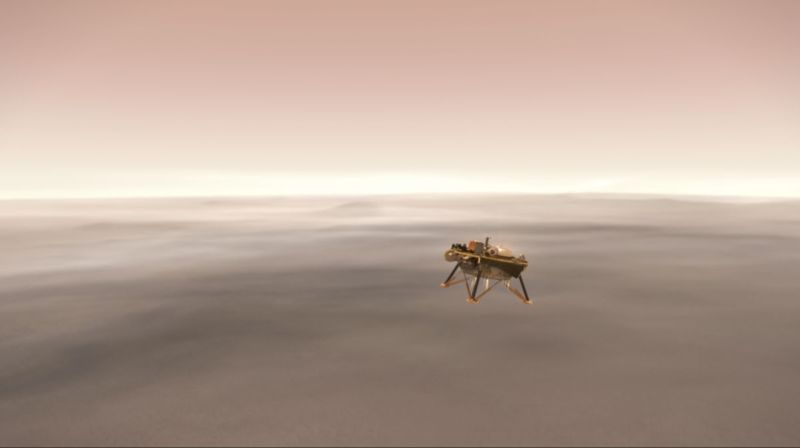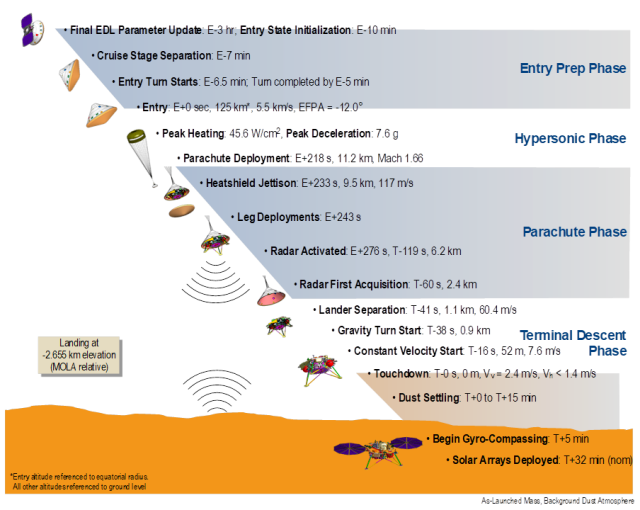
NASA launched the InSight probe to Mars back in early May, and now it's time for the most critical part of the mission—entry, descent, and landing onto the surface of the red planet. The probe will attempt a landing on Monday, Nov. 26, at around 3pm ET (20:00 UTC).
No landing on Mars is easy. Only about 40 percent of the landers and rovers sent to the red planet during the last five decades have ever made it safely down to the surface, and of the international space agencies that have tried, only NASA has succeeded in making a soft landing on Mars.
For InSight, however, mission managers are slightly more confident than usual. This is because the powered descent mode that InSight will employ has been tested before, a decade ago with the Phoenix lander. That spacecraft landed at the north pole of Mars, studied the planet's water cycle, and even observed snowfall.
On Monday, InSight will follow a similar trajectory, entering the Martian atmosphere at an altitude of 125km, and relying on a combination of heat shield, parachutes, and on-board thrusters to mitigate heating and slow its velocity from nearly 20,000 km/hour to about 10 km/h—a factor of 2,000—before its three spindly landing legs touch the surface of Mars.
In recent days, NASA has been commanding the spacecraft to make minor course corrections to ensure InSight enters the Martian atmosphere at the proper angle to within about a quarter of a degree. If InSight comes into too shallow, the spacecraft could skip off the thin atmosphere, and an entry angle that is too steep would produce too much thermal heating.
"Certainly, there are always a number of things that could go wrong," said Stu Spath, Lockheed Martin InSight program manager and director of Deep Space Exploration. Lockheed was the prime contractor for the entire spacecraft, including the landing system. "Landing on another planetary body is in my opinion one of the toughest things that we do in our field."
First contact
InSight will land near the equator, in the western Elysium Planitia, about 600 km north from where the Curiosity rover is presently located. From NASA's Mars Reconnaissance Orbiter, engineers have a pretty good handle on rock abundance in the landing region, which is fairly low, so they don't expect InSight to drop on a boulder. And although it is dust storm season on Mars, there are presently no dust storms raging across the surface.

NASA and Lockheed engineers won't know right away whether the spacecraft has made it safely down to the surface—there is a time delay of 8.1 minutes for communications between Earth and Mars at present. On Monday afternoon, two CubeSats that were launched with InSight, MarCO-A and -B, will relay data about the landing in real-time. They are experimental, however, and NASA is not counting on this data.
As a back-up system, InSight will send one of two tones via a UHF signal to Earth, immediately after touching down. One of those signals will mean that all is nominal, and the other will mean that the spacecraft has landed, but is in "safe" mode for some reason. (If no signal is received, that obviously would be very bad indeed).
Meanwhile, the Mars Reconnaissance Orbiter will record the entry, descent, and landing of InSight in real time, but because of planetary dynamics, that spacecraft won't relay that information back to Earth for about three hours. This will provide detailed information about the landing. About six hours after landing, Earth-based engineers will perform their first real-time relay with InSight, sending data and commands back and forth via the Mars Odyssey spacecraft also in orbit around the red planet.
After the landing, scientists will take it slow and steady with the lander and its scientific instruments. On InSight's sixteenth day on Mars, Sol 16, the lander is scheduled to deploy its seismometer, and on Sol 38 it will deploy a wind and thermal shield to protect the instrument from external noise sources. On Sol 44, InSight will deploy its heat probe, and six days later the lander will begin hammering its probe 5 meters down into the Martian surface. Finally, by March 2, all of the lander's instruments will reach their science-taking configurations, and the real Martian geology will begin.
Read Again https://arstechnica.com/science/2018/11/heres-how-nasa-will-attempt-to-land-on-the-red-planet-monday/Bagikan Berita Ini
















0 Response to "Here's how NASA will attempt to land on the red planet Monday"
Post a Comment